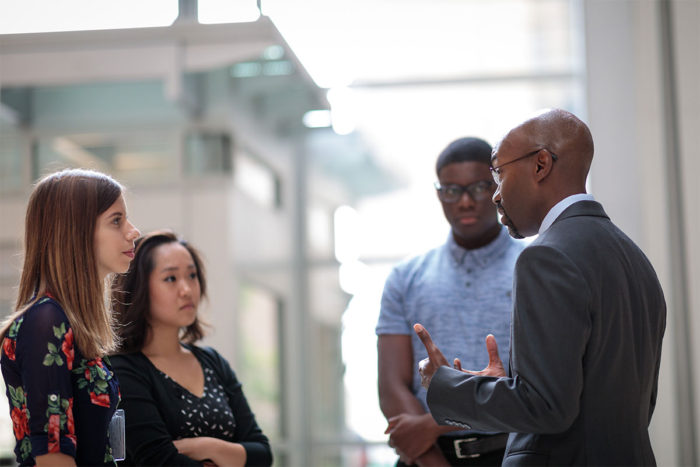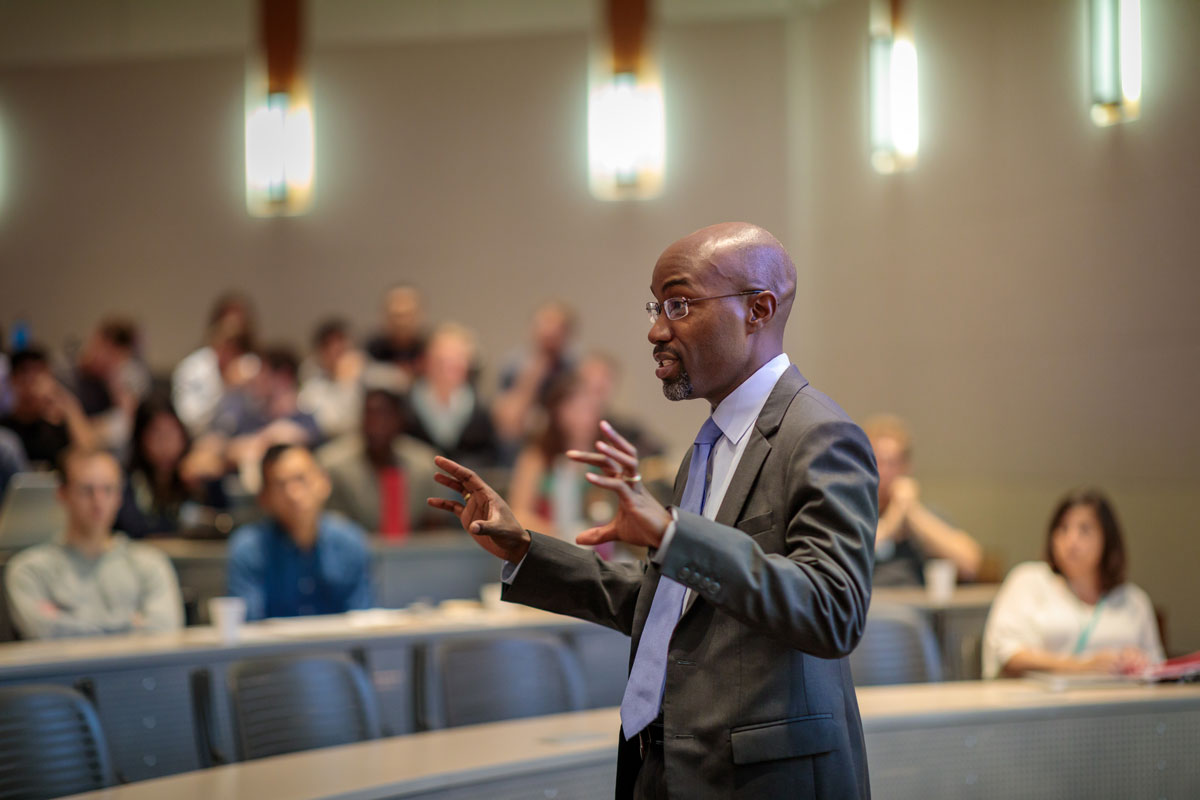Health disparities key focus of medical school orientation
Program helps train future physicians in caring for underprivileged patients
 Matt Miller
Matt MillerFirst-year medical students at Washington University School of Medicine (from left) Talia Pearl, Hannah Truong and Joel Ofori discuss health disparities with Jason Purnell, PhD, an associate professor at the Brown School. Purnell talked with the class Aug. 14 on the Medical Campus as part of the class's orientation program.
The stature of Washington University School of Medicine as a global leader in research, patient care and education lured Hannah Truong from the West Coast to the Midwest to train as a physician-to-be. So, too, did the area’s history, attractions and affordability.
But the school’s ever-strengthening push to teach students about and involve them in the St. Louis community — particularly its underserved neighborhoods — was a major selling point, too. Such an environment, Truong believed, would help shape her into the doctor she wants to become.
“The St. Louis community offers numerous learning opportunities,” said Truong, originally from Bellingham, Wash. “Washington University has become known for its leadership and community outreach in helping the underserved. During my short time on campus, I’ve already learned so much about how social factors such as poverty and racial inequities can negatively affect health. Understanding this is an essential component to medicine.”
The School of Medicine’s hands-on approach to teaching about health disparities started nearly 20 years ago, long before many medical schools considered the topic curriculum-worthy and the Association of American Medical Colleges (AAMC) urged medical institutions and teaching hospitals to consider the social and economic factors influencing health. Public health experts and health-care workers refer to such circumstances as “social determinants of health,” which studies have shown can contribute to significant negative health outcomes.
For this year’s 124 incoming medical students, a crash course in health disparities began immediately, during a four-day orientation known as Washington University Medical Plunge, or WUMP.
“Students learn firsthand about the obstacles to good health and medical care,” said Will Ross, MD, the School of Medicine’s associate dean of diversity and a professor of medicine in the Division of Nephrology. “It’s an intensive, emotional experience meant to translate into more compassionate, patient-centered care.”
Ross founded WUMP in 1999, and it became mandatory in 2014. “Although the program is not new, in recent years, we’ve begun expanding its emphasis on social and structural determinants of health as part of the School of Medicine’s mission to train physicians to look beyond singularly treating a disease or ailment and consider other factors influencing patients’ health,” said Ross, who also has a master’s degree in public health.
WUMP also lays the foundation as the School of Medicine begins to revise its curriculum, said Eva Aagaard, MD, the School of Medicine’s senior associate dean for education and the Carol B. and Jerome T. Loeb Professor of Medical Education. “Understanding social determinants of health is a critical part of our curriculum renewal as well as in treating our patient population,” Aagaard said. “WUMP is an important part of that, but we need to do so much more, both in the training of our students and in the support that we can collectively provide to our community to reduce health disparities.”
The new class’s orientation activities included a visit a few miles north of campus to underserved St. Louis neighorhoods plagued by gun violence, hunger and dilapidated housing. Students also analyzed life expectancy by St. Louis ZIP codes, revealing disproportionate death and disease among the area’s poorest residents in segregated, nonwhite communities.
Additionally, about a dozen of the region’s leading experts spoke to students about gun violence as a public health issue, treating patients who have been victims of abuse or other trauma, and the history of medical mistrust among disenfranchised groups. They learned about century-old racial discrimination in St. Louis that has shaped public policy and societal attitudes, contributing to today’s health-care inequities and racial tension.
During a session with medical students, Jason Purnell, PhD, an associate professor at the Brown School, dissected findings from an April report he co-authored that details St. Louis’ history of racial discrimination and housing segregation while showing its harmful health effects on African-Americans. He explained that wealthy suburbs in St. Louis County have excluded African-Americans from affordable housing through subtle and blatant laws and policies.
“For more than a century, federal, state and municipal policies, real estate practices and development strategies in St. Louis have kept African-Americans in segregated neighborhoods with limited economic and social resources,” said Purnell, director of Health Equity Works, formerly named For the Sake of All, a university initiative that collaborates with community agencies in research and advocacy. “As a result, residents struggle to find quality education, job opportunities and health care. They lack basic necessities such as grocery stores with fruits and vegetables, transportation, clean air and empowering social networks. They’re essentially prevented from building wealth and forced to remain in impoverished communities.”
Health inequities can be seen by ZIP codes. A child born in the wealthy St. Louis suburb of Clayton can expect to live 18 years longer than a child born into poverty in a segregated African-American neighborhood in north St. Louis. “There are fewer than 10 miles between these two communities, but they are worlds apart,” Purnell explained.
One of Talia Pearl’s goals as a future doctor is to help reduce health disparities. “An exceptional physician is one who can provide health care to people of different socio-economic backgrounds, including those who face great obstacles in accessing medical care and health information,” said Pearl, a first-year medical student from Phoenix. “One of the things that attracted me to Washington University was its emphasis on community involvement. To me, an important part of medicine is not just about treating people when they’re sick, but also giving them the resources and information they need for good health. St. Louis is an excellent place to train because it gives us learning experiences in addressing health disparities.”
Added Isabelle Ziebold, a first-year medical student from New York City: “I’m interested in learning how to care for the whole person. WUMP is something that really stood out to me when I interviewed here. The School of Medicine really has placed a focus on interacting with the community to better understand the health needs. The best way to care for these patients is to start now.”
 Matt Miller
Matt Miller





